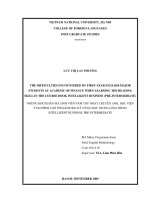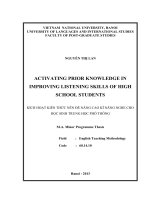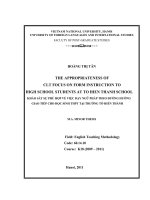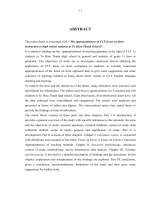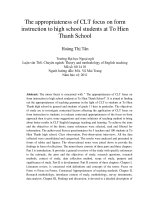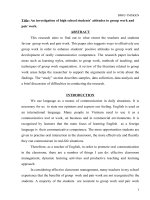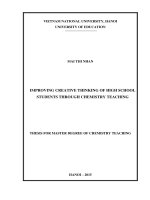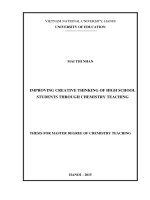skkn an investigation of high school students’ attitudes to group work and pair work
Bạn đang xem bản rút gọn của tài liệu. Xem và tải ngay bản đầy đủ của tài liệu tại đây (183.49 KB, 23 trang )
BM03-TMSKKN
Title: An investigation of high school students’ attitudes to group work and
pair work.
ABSTRACT
This research aims to find out to what extent the teachers and students
favour group work and pair work. This paper also suggests ways to effectively use
group work in order to enhance students’ positive attitudes to group work and
development of orally communicative competence. The research paper includes
areas such as learning styles, attitudes to group work, methods of teaching, and
techniques of group work organization. A review of the literature related to group
work areas helps the researcher to support the arguments and to write about the
findings. The “study” section describes samples, data collection, data analysis and
a brief discussion of difficulties in conducting the research.
INTRODUCTION
We use language as a means of communication in daily situations. It is
necessary for us to state our opinions and express our feeling. English is used as
an international language. Many people in Vietnam need to use it as a
communicative tool at work, on business and in commercial environments. It is
recognised by learners that the main focus of learning English
as a foreign
language is their communicative competence. The more opportunities students are
given to practise oral interaction in the classroom, the more effectively and fluently
they can communicate in real-life situations.
Therefrore, as a teacher of English, in order to promote oral communication
in the classroom, there are a number of things I can do: effective classroom
management, dynamic learning activities and productive teaching and learning
approach.
In considering effective classroom management, many teachers in my school
experience that the benefits of group work and pair work are not recognized by the
students. A majority of the students are resistant to group work and pair work
1
because they think that group work is a waste of time and they are just interested
in working alone, translating or learning vocabulary and grammar. In improving
the teaching and learning of English, there are many innovations to be introduced.
The most important of them is to use pair work and group work in the classroom
whose benefits are to promote classroom interaction which can facilitate second
language acquisition, to personalize the learning process and to increase the
students’ responsibilities for these own learning.
As an attempt to improve the teaching and learning of English, especially
English for communication, I conducted this small scale research project which
took two months, from 1st December , 2011 to 15th February, 2012.
CONTEXT
My school has thirty-four classes with over 1400 students each year, is one
of the biggest schools in Dong Nai, an industrial and commercial province, about
50 kilometres away from Ho Chi Minh City. My school is also located in a place
where there are many foreign visitors each year. Therefore, many people need to
use English to communicate with these foreigners.
In my school, each class has forty-five students who are at different levels,
some with quite competent English, some whose English is not very good, while
others whose English is just getting started. Most of the students are just part-time
ones who go to school in the morning and have to help their parents the rest of the
day. For these reasons, their English is still limited , especially their practice of
English skills. Each of the classes is also equipped with well-lit rooms, enough
tables, a blackboard and a cassette player. As common in other high schools in
Vietnam, the students in my school have to take English as a compulsory subject
and they study English three periods a week .
Together with the curriculum, the current ways of teaching English here are
still traditional. The grammar translation method is mostly used, classroom
activities are heavily teacher-centred and most of the teachers are regarded as the
source of knowledge and students only come to class to get that knowledge. One
more serious problem is that the class size is big in comparison with the accepted
2
norm which is only twenty-five students for each class. Therefore, I think
interactive teaching and learning is impossible without pair work and group work.
RESEARCH QUESTIONS
- What are students’ attitudes to group work?
- What should the researcher do to improve the use of group work?
- Can interesting , interactive and meaningful tasks and activities (e.g.
information gap, role playing) maximize the effectiveness of group work?
HYPOTHESES
Students have positive attitudes to group work and will work well in groups
if they are provided with interesting , meaningful and challenging tasks, clear
instructions and directions and effective guidance by their teachers.
LITERATURE REVIEW
A successful language program depends greatly on appropriate teaching
models chosen by flexible, competent teachers, good learning strategies and
effective classroom management. In communicative language teaching, group
work is considered a useful and effective technique to assist learners to use the
language in class and then in real-life situations. Defining the term “group work”,
Brown ( 1994: 173) says, “ It is a generic term covering a multiplicity of
techniques in which two or more students are assigned a task that involves
collaboration and self-initiated language”. In considering the advantages of group
work , Ur (1996:232) states that group work is a form of learner activation which is
of particular value in the practice of oral fluency, and learners in a small group can
get five times as many opportunities to talk as in full-class organization. She also
emphasizes that group work fosters learners’ responsibility and independence,
helps to improve motivation and contributes to a feeling of co-operation and
warmth in the class. When students are put in groups, they can help each other to
carry out interviews, to play roles in a dialogue, to do problem solving, surveys,
and values clarification. In agreement with Ur, Harmer (1998:21) says, “the other
3
advantage of group work and pair work ( but especially group work) is that they
give the teacher the opportunity to work with individual students”. He also adds
that group work gives the students chances for greater independence because when
students work in groups, they take some of their own learning decisions. They
can work without the pressure of everybody listening to what they are speaking or
watching what they are doing.
Group work ; however, has some problems the teacher should take into
account so that he or she can maximize its effectiveness. Ur (1996:232) points out,
“ In individual classes, group work may encourage students to be more disruptive
than they would be in a whole class setting”. Obviously , in groups without the
teacher, students can make unneccesary noise or use their own language. Brown
( 1994:177) emphasizes, “ Many students, especially adult-age students, prefer to
work alone because that is the way they have operated ever since they started
school”. He adds that some students find group work frustrating since they only
want the teacher to give them the answers to the problems.
In solving the above problem of group work, Brown (1994:177) suggests
that we should be sensitive to our students’ preferences and help them to see that
language is for communicating with people and that the more they engage in face to - face communication, the more their oral communicative competence will
improve. He also mentions that problems of group work, such as some members of
a group being reluctant to share information with the others, can be solved by
careful planning and management and by interactive, interesting and relevant tasks,
for example practising dialogues with a partner, question and answer exercises,
performing certain meaningful substitution “drills”, games, information gap tasks,
interviews, problem solving and decision making activities. Lynch (1996:115)
says, “ when setting up group work, one of the teacher’s important decisions is
who is to work with whom”. In his book, Doff ( 1988: 142 ) says that clearly
defined tasks, clear instructions about when to start, what to do, and when to stop
as well as teacher demonstration before students work on tasks. All of them can
4
help students to know exactly what to do and they, as a result, get more involved in
group work.
Ur ( 1996 : 234 ) states that we should give the instructions before giving out
materials or dividing the class into groups, and a preliminary rehearsal or “ dry
run” of a sample of the activity with the full class can help to clarify things.
In explaining the advantages of group work, Brown ( 1994:173) says that
group work helps to solve the problem of classes that are too large to offer many
opportunities to speak. He also emphasizes that group work offers the security of
smaller groups of students where each individual is not so starkly on public
display, vulnerable to what the student may perceive as criticism and rejection,
and group work promotes learner responsibility and autonomy.
DEVELOPMENT
From the literature review, we can see that many authors like Brown, Ur,
Harmer, Doff, and Lynch who have great influence in the area of group work
organization and English language teaching and learning , define that appropriate
and good classroom management, flexible classroom activities and interesting
tasks are key factors which contribute to a success of a language programme.
Based on students’ backgrounds , their learning needs and my analysis, I realize
that there is a need for a new appropriate approach to language teaching and
learning in my school which will shift the focus of attention from teacher-directed
to student-centred teaching and learning environment with the effective use of
group work and pair work and the communicative approach as the key to improve
students’ performance as well as their outcomes. The main reason is that teacherdirected and teacher-dominated classrooms with poor tasks cannot be naturally
interactive.
METHODOLOGY
A. Subjects
This study was conducted with the students of the 12 th form in my school.
Among twelve classes of 12th form, I chose two classes: 12A1 and 12B8 to carry
out the surveys. Their age ranges from 17 to 18. Some of them were familiar with
5
group work , while others were not. Twenty students in each of these two classes
were selected at random for the research. I chose these two groups of students
because they had learning styles, learning needs, study habits and attitudes that
were commonly shared by other students in my school and in many other high
schools in the province.
In addition, two teachers of English in the school: Huy and Tien were
interviewed. I chose these two teachers because they appeared to be active and
hard-working and they agreed to help me to carry out the research. These teachers
had earned a bachelor degree in English language teaching and had much teaching
experience. I also learnt from discussions with them that they were aware of the
benefits of group work for second language acquisition and they had made
attempts to use it with varying degrees of success in their classes.
B. Instruments
In order to gather information about my students, and classroom activities, I
used three instruments: the class evaluation form, the questionnaire and the
interview. I believe that data is more reliable if it is collected from different
sources and with different methods. In considering the reliability of data, Wallace (
1998: 210) says,“ Triangulation should make our findings more reliable, and
subjecting them to different people’s scrutiny within the action research team
should make the findings more valid”.
+ The Class Observation Form
I designed this form in order to evaluate the teachers and students’
performances, attitudes and activities in the classroom. Bell ( 1997: 109) says,
“
Direct observation may be more reliable than what people say in many instances. It
can be particularly useful to discover whether people do what people say they do,
or behave in the way they claim to behave". I invited one more teacher in the
school to conduct this evaluation form. I strongly believe that the observation
results are more reliable because “reliability is enhanced by having two observers (
the second may be the researcher himself or herself) observe the same behaviour at
6
the same time, either in the field or on a video tape” ( Slavin, 1992:93). The class
evaluation form includes two parts: the first is about the teacher, the second is
about the students and activities in the classroom. Each part consists of some
statements ( please see appendix 1). The rating scales of the statements vary as
follows:
1. Not at all
2. Slightly
3. Neutral
4. Very
5. Completely
+ The Questionnaire
The designed questionnaire is anonymous so that the students may not conceal
their real feelings when they comment on their teacher and his or her teaching. The
questionnaire used closed and open questions ( please see appendix 2). It covered
different fields related to students, their attitudes and language learning, including
learners’ purposes, expectations, learning habits, learning styles and preferred
forms of classroom organization. The purposes of the questionnaire instructions
and the reasons for the research were clearly explained to the learners because “ if
the pupils understand the reason for the research and are interested in its outcomes,
a questionnaire can produce very reliable data and, at the same time, make a
contribution to improving the situation”, Altrichter Posch & Somekh ( 1993: 114).
+ The Interview
I asked the teachers ten questions ( please see appendix 3) related to the
students’ attitudes , learning styles and the teachers’ techniques of classroom
organization or management. All the dialogues in the interview were carefully
recorded. The staff included only two teachers, all the questions on the survey
were open-ended. When I did the research, I made questions in Vietnamese so that
I could get real information from my students. The duration for the interviews were
reported to the teachers before the interview.
7
Questioning , orally or in writing, often more direct access to the meaning it
has for the pupil than do other methods. I told my students that the responses
would help me to improve my teaching and their learning of English because “ the
interviewee should believe that the outcomes of the interview are useful for him or
her” (Altrichter, Peter Posch and Bridget Somekh 1993 ; 101 )
C. Data Analysis
+ Class observation data analysis
There are twenty statements, describing the students’ learning styles and
attitudes, and the teachers’ teaching methods. There are two tables presented in
this section. One presented comments on the teaching methods, techniques and
skills of group work organization, while the other presented students’
involvement in group work.
The data presented in each table show the frequency distribution of each
statement. The numbers shown in the frequency distribution indicated the majority
ratio integrated from five rating scales.
Table 1: Teacher Evaluation
• Comments on the teaching approaches , group work organization
Frequency Distribution
Statements
Positive
Number
Scale(%)
Neutral
Number
Scale(%)
Negative
Number
Scale(%)
1. The teacher’s instructions are clear.
2. The tasks are clearly explained to
students
3. The teacher demonstrates how to do the
task.
4. The teacher organizes the group well.
5.The techniques are appropriate for each
stage of the tasks.
6. The teacher shows interest in the
8
students’ work .
7. The teacher offers help when needed.
8. The teacher is flexible and uses many
effective techniques.
9. The teacher sometimes joins in a group.
10. The teacher answers students’
questions about the tasks given.
11. The teacher is cheerful and friendly.
12. The teacher skillfully selects group
members, group leaders.
13. The teacher signals for everyone’s
attention.
Table 2 : Student Evaluation
• Students’ Involvement in group work
Frequency Distribution
Statements
Positive
Number
Scale(%)
Neutral
Number
Scale(%)
Negative
Number
Scale(%)
14. Students are involved in group work .
15. Students feel relaxed and free to learn
in groups.
16. Students co-operate with each other.
17. Students participate in doing tasks.
18. Students understand the teacher’s
instructions
19. Students show interest in the lesson.
20. Students use more L2 than L1 in class.
• Questionnaire Data Analysis.
9
The questionnaire consists of 36 questions related to the students attitudes, learning
styles, learning preferences and the teacher’s methods of teaching. There are two
tables presented in this section.
Table 1: Students’ learning preferences
Table 2: Students’ attitudes to group work and the teachers’ methods of
teaching.
The two tables below will show the frequency distribution of each statement.
The numbers shown in the frequency distribution indicate the exact number of
students’ responses to the questionnaire.
Table 1: Students’ Learning Preferences
Frequency Distribution
Statements
Positive
Number
Scale(%)
Neutral
Number
Scale(%)
Negative
Number
Scale(%)
1. Working in pairs/groups
2. Working in the whole group
3. Working only by myself.
4. Working in small groups.
5. Working in one large group.
6. Talking to other students.
7. Discussing with others.
8. Working with fluent speakers of
English.
9. Working on new exercises/tasks.
10.Talking only to my teacher.
11.Working with my close classmates.
12.Talking to English speaking people.
13.Teacher’s lecture.
14. Doing exercises and being given
answers by the teacher.
15.Small group work
16.Role-plays
10
17.Whole class discussion
18.Teacher’s translation
19.Students’ translation
20.Writing what my teacher provides and
explains to me.
Table 2: The students’ attitudes to group work and the teacher’s methods of
teaching.
Frequency Distribution
Statements
Yes
Number
No
Scale(%)
Number
Scale(%)
21. Group work is interesting
22. Group work is useless
23. Group work is time-consuming
24. Group work helps me a lot in learning English.
25. Group work helps me to work with many
friends
26. She/he wants us to help one another
27. She/he wants to increase classroom interaction
28. She/he wants us to make friends with one
another.
29. She/he does not want to teach
30. She/he has not prepared her/his lesson
31. Tasks are interesting
32. Tasks are boring
33. Tasks are useless
34. Tasks focus on grammar
35. The teacher’s instructions are clear and simple
36. Games are interesting.
+ Interview Data Analysis
There are ten questions dealing with the students, teachers and their methods of
teaching in the interview. The data was presented in the form of qualitative
analysis.
11
+ Time-line
My research was lasted for two months from 1st December, 2011 to 15th February
2012, and I was able to get enough time and preparation to collect data from the
students as well as teachers.
The following time line illustrated what I did for my research report.
The first week
- Wrote an outline
- Draw a concept map
The First Month
( December, 2011)
and design questionnaire items
The second week - Trialed the questionnaire.
The two weeks
- Observed
After the second
The first week
- Redesigned Questionnaire, Interviews
The second month The second week - Conducting Questionnaire, Interviews
(JanuaryFebruar
y,2012)
The third week
- Analyzed Data
The fourth week
- Wrote up the research paper
- Wrote recommendations
FINDINGS
The first survey which I administered to the above - mentioned group of
students surprisingly indicates that they were very interested in improving
communicative English competence. 80 % of the students needed to improve their
interactive English. They are interested in learning by doing things. Additionally,
the survey shows that the students had a variety of methods to practise English
outside the classroom , for example reading magazines, newspapers, looking up
unfamiliar words in dictionaries, practising English with friends and classmates.
The students did not like the traditional methods, the most commonly used
methods of teaching in High Schools in Vietnam. They are grammar translation,
lectures in the classroom and homework which is then corrected in class. Their
responses show that such traditional methods make the group of students bored
and frustrated. Instead, they were keen on being given effective teaching and
12
learning methods. 74 % of the students liked working in small groups to carry out
communicative activities and tasks. They liked to make responses to
questionnaires, interviews. They also enjoyed discussing with one another in
groups.
A. Learning styles.
Question 1: How would you like to study English?
The questionnaire data revealed the following:
- 37 students = 74% of the students liked to work in pairs and groups.
- 5 students = 10% of the students liked to work alone.
- Only 16% of the students (8 students) liked to work in the whole group.
Comment : The majority of students like to work in pairs and groups.
Question 2: How often would you like to have the following teaching methods in
your class ?
- 82% of the students (41 students) want their teacher to use group work in class
often.
- Only 3 students (6% of the students) like to have lectures and translation in
class.
Comment: The majority of students do not like traditional methods of teaching
and learning.
CLOSING REMARKS
I have described the ways to carry out small scale research on students’
attitudes to group work in my school. The brief literature review emphasized the
advantages and disadvantages of group work and some techniques of group work
organization. The three surveys, which contained students’ attitudes, learning
preferences, teacher’s approaches of teaching, and classroom activities, were the
main tools for collecting data from students. The quantitative analysis of the
questionnaire, observation form and the qualitative analysis of the interviews
helped me to get reliable data from students. It is the first time to conduct research,
13
and there were some possible problems which included students’ being
uncooperative funds and time limitations. These problems were solved by the
following ideas:
+ The reasons for the research, and purposes of data collection were clearly
explained to the administrators, teachers and students.
+ I made my administrators believe in the importance and validity of my research.
+ The duration of the research project was well-organised.
Through the survey, I did understand much about my students . I need to
design relevant, appropriate tasks so that I can help my students to effectively
achieve their communicative goals.
RECOMMENDATION
In English teaching, we are more successful and our approaches of teaching
English are more effective if we know clearly about our learners’ problems, their
learning preferences and strategies. Through empirical methods, we can understand
our learners so that we can help them to improve their language skills. I carried out
this research by using the three surveys stated above. I know there are other tools
which are available such as discussion and keeping diaries, but I could not use all
of them because of time limitations. The participants involved in the research come
from only one school. Through the research I found out possible solutions to the
problems of group work in high schools in Viet Nam. One more important thing is
that I improve my students’ attitudes to group work. The research proves, I think,
that in the Vietnamese teaching situations, interactive teaching is impossible
without group work.
Through the research, I had opportunities to improve my readings skills,
especially reading academic texts. I also used much terminology which helped me
understand concepts and ideas of research and teaching areas.
14
BIBLIOGRAPHY
- Altrichter, Herbert, Peter Posch and Bridget Somekh, 1993 , Teachers
Investigate Their Work: An Introduction To The Methods Of Action Research,
Routledge , London.
- Altrichter, H, Posch, P & Somekh, B, 1993, Teachers Investigate Their Work,
Poutledge.
15
- Bell, Judith , 1997 , Doing Your Research Project , Open University Press ,
Buckingham , Philadelphia.
- Brown , H. Douglas , 1994 , Teaching By Principles: An Interactive Approach
To Language Pedagogy, Prentice Hall Regents, Englewood Cliffs, New Jersey.
- Doff, Adrian, 1988, Teach English: A Training Course For Teaching, CUP ,
England.
- Harmer, Jeremy , 1998 , An Introduction To The Practice of English Language
Teaching, Longman Ltd , England.
- Lynch , Tony , 1996 , Communication in the language classroom , Oxford
University Press , Oxford.
- Slavin, Robert E.,1992 , Research Methods In Education, Allyn and Bacon,
USA.
- Ur , Penny , 1996 , A Course In Language Teaching , Cambridge University
Press , Cambridge.
- Wallace , Michael , 1998 , Action Research for Language Teachers ,
Cambridge University Press.
NGƯỜI THỰC HIỆN
Nguyễn Trần Quốc Việt
Appendix 1
LONG THANH HIGH SCHOOL
Research Project
CLASS OBSERVATION FORM
There are five rating scales which vary as follows.
1. Not at all
2. Slightly
3. Neutral.
16
4. Very.
5. Completely.
Teacher Evaluation
1. The teacher’s instructions are clear and simple
1
2
3
4
5
2. The tasks are clearly explained to students
1
2
3
4
5
3. The teacher demonstrates how to do the task.
1
2
3
4
5
4. The teacher organizes the group well.
1
2
3
4
5
5. The techniques are appropriate for each stage of the tasks.
1
2
3
4
5
6.The teacher shows interest in the students’ work.
1
2
3
4
5
7. The teacher offers help when needed.
1
2
3
4
5
8. The teacher is flexible and uses many effective techniques.
1
2
3
4
5
9. The teacher sometimes joins in a group.
1
2
3
4
5
10. The teacher answers students’ questions about the tasks given. 1
2
3
4
5
11. The teacher is cheerful and friendly.
1
2
3
4
5
12. The teacher skillfully selects group members, group leaders.
1
2
3
4
5
13. The teacher signals for everyone’s attention
1
2
3
4
5
STUDENT EVALUATION
14. Students are involved in group work.
1
2
3
4
5
15. Students feel relaxed and free to learn in groups.
1
2
3
4
5
16. Students co-operate with each other.
1
2
3
4
5
17. Students participate in doing tasks.
1
2
3
4
5
18. Students understand the teacher’s instructions
1
2
3
4
5
19. Students show interest in the lesson.
1
2
3
4
5
20. Students use more L2 than L1 in class.
1
2
3
4
5
Appendix 2
LONG THANH HIGH SCHOOL
REASEARCH PROJECT
QUESTIONNAIRE
( Learning Styles and Attitudes to Group Work )
17
The purpose of this survey is to find out about your learning styles and
attitudes to group work. Your responses will help us to improve your
learning.
You do not need to write your name on this form.
1. How would you like to study English?
* Please indicate your attitudes towards the following areas by circling the
appropriate number.
1. I do not like this at all.
2. I do not like this very much.
3. This is okay.
4. I quite like this.
5. I like this very much
1. Working in pairs/ groups
1
2
3
4
5
2. Working in the whole group.
1
2
3
4
5
3. Working only by myself.
1
2
3
4
5
4. Working in small groups.
1
2
3
4
5
5. Working in large groups.
1
2
3
4
5
6. Talking to other students.
1
2
3
4
5
7. Discussing with others.
1
2
3
4
5
8. Working with fluent speakers of English.
1
2
3
4
5
9. Working on new exercises/tasks.
1
2
3
4
5
10.Talking only to my teacher.
1
2
3
4
5
11.Working with my close classmates.
1
2
3
4
5
12.Talking to English Speaking people.
1
2
3
4
5
2. How often would you like to have the following teaching methods in your
class.
* Please indicate your attitudes to the following areas by circling the
appropriate number.
1. Never
2. Occasionally.
18
3. Sometimes
4. Usually
5. Always
13.Teacher’s lecture .
1
2
3
4
5
14.Doing exercises and being given answers by the teacher
1
2
3
4
5
15.Small group work
1
2
3
4
5
16.Role-plays
1
2
3
4
5
17.Whole-class discussion
1
2
3
4
5
18.Teacher’s translation
1
2
3
4
5
19.Students’ translation
1
2
3
4
5
20. Writing what your teacher provides and explains to you.
1
2
3
4
5
3. What is your opinion of group work?
21. Group work is interesting
Yes
No
22. Group work is useless
Yes
No
23. Group work is time-consuming
Yes
No
24. Group work helps me a lot in learning English.
Yes
No
25. Group work helps us to be more co-operative
Yes
No
26. She/he wants us to help one another
Yes
No
27. She/he wants to increase classroom interaction
Yes
No
28. She/he wants us to make friends with one another.
Yes
No
29. She/he does not want to teach
Yes
No
30. She/he has not prepared her/his
Yes
No
4. Why does your teacher use group work ?
5.What do you feel about your teacher ‘s tasks and instructions?
31.Tasks are interesting
Yes
No
32. Tasks are boring
Yes
No
33. Tasks are useless
Yes
No
34. Tasks focus on grammar
Yes
No
19
35. The teacher’s instructions are clear and simple
Yes
No
36. Games are interesting.
Yes
No
Thank you very much for your co-operation
Appendix 3
LONG THANH HIGH SCHOOL
RESEARCH PROJECT
INTERVIEW
( Teacher Survey)
20
The purpose of this survey is to find out how you use group work in the
classroom. Your responses will help us to improve our students’ attitudes to
group work and our teaching.
1/ How often do you use group work in class ?
_ I sometimes use group work. I know it is important, but I do not have enough
time to prepare tasks for my students. So I just teach by lecturing.
2/ What kinds of tasks do you use to teach the class ?
_ Tasks in the text book. Those are some exercises related to the reading topic.
3/ Do you repeat your instructions after your students start on a task?
- Yes, sometimes I repeat, but not always. My students want me to give instructions
in Vietnamese.
4/ How do your students feel when you use group work?
- If I have relevant, interesting task, they feel interested in doing, but if I use the
tasks in the book, they feel bored and frustrated.
5/ What do you think the learning needs of the students are ?
- In discussion with them, I know they need English for communicative purposes,
they want to speak English to Australian, English, American people.
6/ Which of the following factors do you consider to make your tasks
interesting?
a. Relevant topics: √
________________________________________________________________
b. Students’ interest : √
________________________________________________________________
c. Students’ level of English : √
____________________________________________________________
d. Simplicity of activities : √
__________________________________________________________________
e. Others ( please specify)
- I also consider meaningful practice. For example if the students work in groups
to play roles in a dialogue, they then make another dialogue themselves. My
21
students increase their talking time and enjoy talking and exchange information
about their own things. They do not like mechanical practice.
7/ Which of the following measures do you consider when some students
refuse to work in groups ?
a. Advising and talking to each student : √
_____________________________________________________________
a. Making clear the purposes of the activity to each student : √
____________________________________________________________
b. Talking to your colleagues about your students’ problem :
- I do not usually talk to my colleagues about my students’ problems.
8./ To what percentage do you depend on group work?
- 30% - I do not have enough time to design tasks for my students.
9/ Do you demonstrate how a task should be done ?
- Yes, but not very often, because I think I do not have time.
10/ Are your instructions simple and clear ?
- I think they are O.k. But sometimes my students cannot do the tasks, I have to
repeat my instructions.
Thank you very much for your co-operation
TABLE OF CONTENTS
Page
Abstract
1
Introduction
1
22
Context
2
Literature Review
3
Development
5
Methodology
5
Findings
12
Closing Remarks
13
Bibliography
16
Appendix 1
17
Appendix 2
18
Appendix 3
21
23


